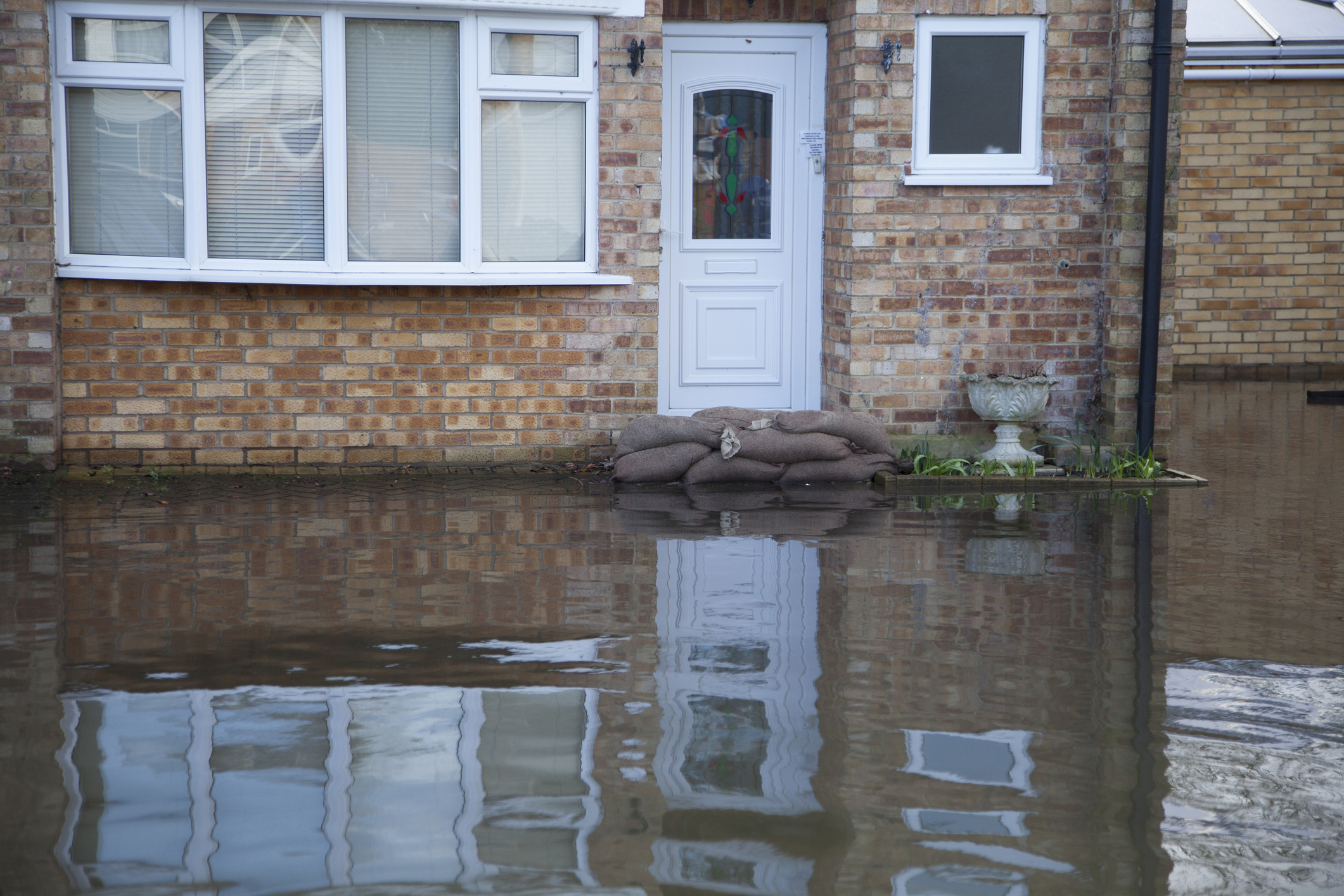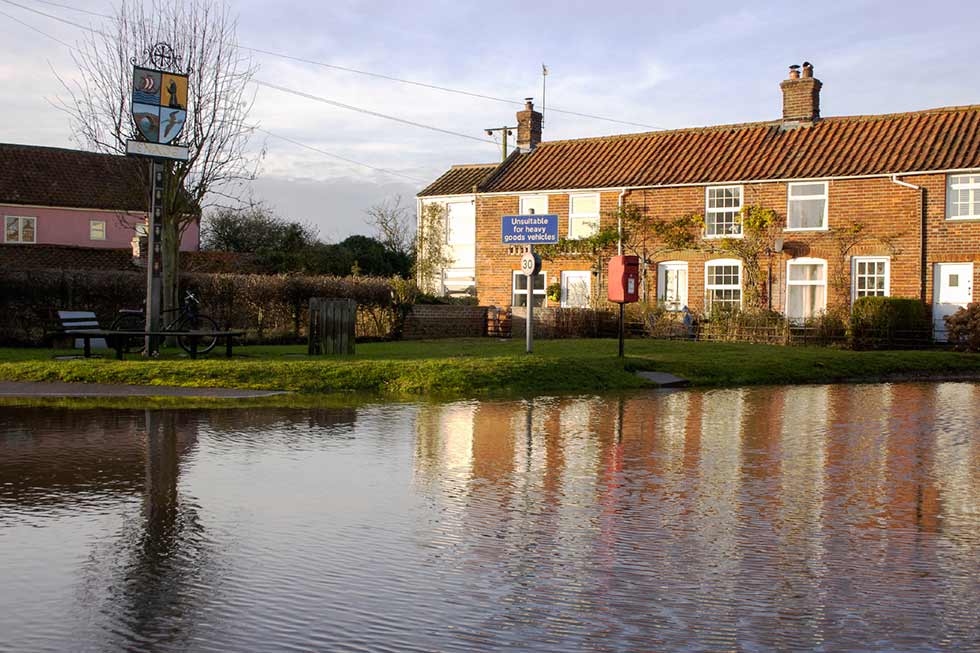
Are you caught up in a flash flood? With the north of England experiencing highly destructive and dangerous flooding, and other parts of the country vulnerable to flash floods throughout autumn and winter, what can you do to protect your home against the worst of the damage?
Flooding can be extremely damaging to property and gardens, so if you see a MetOffice warning of flash floods in your area, if you live near a river that's been known to burst its banks, if you live in a basement flat, particularly at a dip in the road, it makes sense to prepare for a flash flood as far in advance as you can.
For all advice that covers immediate danger to your own personal safety (or to your children's or pets'), read the official guidelines issued by the government. For preparing your home and garden, read our advice.

Winter floods: why you need to be prepared
UK winters are getting wetter, with flash flooding events becoming more likely every year. Five out of six wettest UK winter on record have occurred since the year 2000, and December 2015 was the wettest December on record.
North Atlantic storms are also getting stronger, bringing more wet weather with them every winter. For all these reasons, if you live in an area prone to flooding, preparation – and, if possible, proper flood proofing – is essential to protect your property.
If water is rising, here's what to do
- Move all personal effects, valuables, perishables, documents and sentimental items such as photographs upstairs or to a safe place;
- Create your own flood gates for your entrances – use sandbags (see below);
- Use a sealant around areas where any external pipes enter your home;
- Apply covers to external air vents;
- Check external walls for holes and seal any gaps;
- Shut external doors – ideally they should seal tightly (more on this below).
Sand bags: how to choose and where to buy
A note of caution: if the flood is caused by rising ground water, sand bags will not protect your home. However, they are effective, up to a point, if the flood is caused by a river bursting its banks. You can get sand bags from your local council.
Alternatively, you can buy them either ready filled or buy just the bags (made either from jute or polypropylene), and fill them yourself with coarse sand. Bear in mind that sand bags should never be overfilled, or they will not mould properly to the gaps they need to cover.
Flash floods: what to do if you live on a flood plain
Basically, if you live anywhere near water, e.g. a river, you live on a flood plain. Properties that are built on ground that's below sea level are also at risk even if they are relatively far away from water. While there might be little you can do to prevent the flooding itself, there are things you can do to ensure the inside of your home is damaged as little as possible.
Have flood-proof doors and windows installed, and pay particular attention to the basement of your house: inadequate or incorrectly built drainage can have a catastrophic impact on your house, so have your basement assessed and waterproofed by a professional. It will cost you (in the region of £10,000 to £20,000), but it's worth it. Look, too, at having a sump pump fitted – more on that below.
These measures will also make insurers more willing to cover your home.
Flash floods: what to do if you live in a basement flat
It goes without saying that if you live in a basement property, the risks of damage from flooding are much, much higher. Here's what you can do to protect your home and your possessions:
- Make sure all flooring is stone, or at least wood, never carpet;
- Varnish all skirting boards with a waterproof varnish, or replace wooden ones with waterproof plastic skirting boards;
- Fit pipework with non-return stop valves, to prevent sewage from overflowing into the property during a flood;
- Invest in a sump pump (see below) or at the very least, a submersible pump (again, see below);
- Store as many appliances and possessions as you can you on wall mounted, high shelves;
- Keep valuable possessions (including winter coats) in sealed plastic bags.
Investigate having a sump pump fitted
It's also worth investigating having a sump pump fitted into a basement. These are installed into the lowest part of your basement (or even crawl space) and will remove excess water that enters the sump pit and into the drain network or through the soil to stop your basement becoming overwhelmed. These aren't cheap, however – expect to pay up to £1,000 (but be ready to recoup that on unspoiled flooring, skirting and wallcoverings...).
Buy a cheaper flood pump if you're renting
Flood pumps won't prevent your basement or lower floors from flooding but they are good for pumping the water that's entering the property back out. Flood pumps are usually powered by mains electricity – you might have one already if you have a pond in your garden – so you'll have to be very cautious in their use (and use a residual current device (RCD) to be on the safe side).
Flash floods: how to protect your garden
First of all, do prepare yourself for some damage, as it's inevitable. But you can reduce it using the following tips:
- Make sure gutters and drains are clean and free of buildup; you should clear all drains at least once a year, in the spring;
- Level sloped areas if at all possible;
- Cover water features with netting;
- Create run-off paths that will redirect water and distribute it more evenly;
- Plant an area of the garden with grass; even if it's not a full-on lawn, a grass patch will absorb some of the water;
- Mulch heavily with bark and leaf mould before the flood to prevent plants from becoming waterlogged;
- Avoid non-permeable materials such as concrete; opt for permeable gravel instead.
What to do after the flood has subsided
There is little you can do until the water levels subside, but contacting your insurance company should take priority (see below). Push to ensure your claim is processed quickly so you can plan repairs as soon as possible.
First, what not to do:
- Do not turn electricity and gas supplies back on until you have had professional advice that it is safe to do so;
- Wear protective equipment while cleaning up due to the risks associated with contaminated water;
- Seek qualified, professional advice on repairing damage and restoration work, including using a registered electrician and Gas Safe registered engineer.
Start by removing any wet soft furnishings, such as sofas and carpets, from the house, then (if the rain has stopped), open windows and run dehumidifiers (see our pick of the best dehumidifiers for the job).
Flash floods: does my home insurance cover them?
Generally speaking, yes (and this includes both external damage and damage to the contents of your home), although some insurers may be unwilling to cover you if you live in a location susceptible to flooding. Others will cover you, but may decide to set higher premiums on your home insurance payments.
This is partly due to the recently launched Flood Re scheme, into which all UK home insurers must pay so that there's enough to cover those affected by floods. To be eligible for this scheme, your home must have been built before 2009 and be in council bands A to H. Some insurers will pass on the costs of contributing to this fund to their customers.
Your insurance company should be able to provide you with a flood remediation expert who can assess your building and advise the most suitable course of action. However, should you source an independent specialist yourself, it is crucial to locate one through quality controlled websites to avoid falling victim to rogue traders. Start with the Property Care Association or Trust Mark list trusted flood remediation specialists.
More on property care:
Join our newsletter
Get small space home decor ideas, celeb inspiration, DIY tips and more, straight to your inbox!
Anna is a professional writer with many years of experience. She has a passion for contemporary home decor and gardening. She covers a range of topics, from practical advice to interior and garden design.
-
 How to make compost — 8 easy steps gardening pros always use
How to make compost — 8 easy steps gardening pros always useLearn how to make compost at home in seven easy steps, whether you have a bin or want to create a compost heap. We've asked pros for their top tips
By Eve Smallman
-
 Planting ornamental grasses — the best types experts love and how to grow them
Planting ornamental grasses — the best types experts love and how to grow themWe've got you covered on planting ornamental grasses, speaking to experts about what ones to grow, how to grow them, and factors to consider
By Eve Smallman
-
 "Grotty" terrace is transformed with French flair and Ibiza vibes in the garden
"Grotty" terrace is transformed with French flair and Ibiza vibes in the gardenEsther Pillans' tired-looking Victorian terraced house was given a makeover with a touch of Parisian chic
By Ellen Finch
-
 Rock garden ideas – 10 DIY ways to create a rockery
Rock garden ideas – 10 DIY ways to create a rockeryThese rock garden ideas are suitable for outdoor spaces big and small. Create your own rockery on a lawn or even on a balcony with just a few materials.
By Anna Cottrell
-
 Cabin fever? These chimineas will extend the life of your patio
Cabin fever? These chimineas will extend the life of your patioThis cold-weather season, cozy up to our favorite chimineas!
By Brittany Romano
-
 5 outdoor summer essentials to prove Society6 is your one-stop-shop this season
5 outdoor summer essentials to prove Society6 is your one-stop-shop this seasonCheck off all of your outdoor summer essentials by shopping exclusively at Society6.
By Brittany Romano
-
 The first-ever Etsy outdoor sale is happening now, and we're buying these 5 items
The first-ever Etsy outdoor sale is happening now, and we're buying these 5 itemsFor a limited time, this Etsy outdoor sale will give your backyard the facelift it needs — at a fraction of the cost.
By Brittany Romano
-
 The benefits of houseplants – 8 feel-good ways plants help your health
The benefits of houseplants – 8 feel-good ways plants help your healthEnjoy the many benefits of houseplants. Air-purifying, anxiety-soothing, mood boosting and more positive vibes.
By Camille Dubuis-Welch